
Managing a successful business project is all about setting and establishing aims and objectives that would lead to acquiring information for supporting the business operations and also ensure about successful business conduction. The study revolves around the case overview of Nestle and its project management that encompass of project management that highlights about the cost, time, quality management structure along with work breakdown structure and Gantt chart. Research has also been assisted with the help of quantitative and qualitative research question asked to the managers in order to acquire their perception about how a business like Nestle can be successfully managed.
Nestle is found to be one of the most leading food producer from 135 years and operates itself globally. The respective company is wholly concerned and inclined towards maintaining their organizational culture, responsibility towards nutrition, quality and safety of food and business principles. Estimates revenue generation of the company is believed to be 9,143 crores CHF. (Nestle.com, 2019)
LO 1:
P1. Devise project aims and objectives for the chosen topic.
Theory of Liberalization states that in the rudimentary level globalization is considered as result that aims at fulfilling the political liberty and economic welfare of a country (Crane et al., 2016). In contrast to that, the advocate of Theory of Political Realism explains globalization addresses the state power to protect the national interest (Beck, 2018). To put it another way, the main purpose of globalization is to balance the power wherein the attempt of achieving the world dominance is effectively countered by collective resistance. However, Turner and Holton, (2015), stated that Theory of Marxism views the globalization process as an opportunity for making surplus from the world interconnectivity. This theory is strictly a counterpart of liberalist and political realist theory.
The model of Old School Recruitment and Selection holds that in order to fill the vacant job posts the process of recruitment should start with attracting the workforce through advertisements, thereafter the response from the candidates evaluating each prospects and conducting interviews ( Bratton and Gold, 2017 ). In this context, the model of Fully Outsourced Recruitment and Selection is considered as an appropriate approach for multinational companies because it offers certain benefits to the organizations like lowered labor and technological costs and better result in stipulated time ( Lander and Schmidt, 2016 ).
The system model of training is composed of five phases namely analyzing, designing, developing, executing, and evaluating ( Hanapiyah et al., 2019 ). For the purpose of achieving best organizational results these five phases should be repeated and hence this model ensures that the employees can match the organizational standards ( Bompa and Buzzichelli, 2018 ). In contrast to that, the Transitional Model of Recruitment emphasizes on the entire organization that is the outer loop of the model defines the organizational mission, vision and values ( Sharf, 2016 ). Based on this loop the training model that is the inner loop of the model is designed. However, the scope of the Instructional System Development Model of Recruitment is wide from these two models that is this particular model address the training related issues and also effectively contributes in developing organizational strategies for further development ( Sitzmann and Weinhard, 2018 ).
The aim of the project is to investigate and analyze the ways in which the multinational companies recruit, select and train their employees, for meeting the International standards and requirements.
· To understand the concept of recruitment, selection, and training within multinational organizations as well as its importance
· To investigate the steps taken up by multinational organizations for ensuring appropriate recruitment, selection and training procedures, for meeting international standards
· To recommend strategies regarding the efficient ways in which the current steps adopted by the companies can be improved
P2. Produce a project management plan that covers aspects of cost, scope, time, quality, communication, risk and resources.
Estimated Cost per hour (€)
(Source: Created by Author)
In this study, the influence of effective recruitment and selection process has been put forth and the importance of acquiring effective workforce has been determined. Along with this, the importance of training and development process, emphasizing on individual development and their responsibility, strong leadership and commitment towards life-long organizational objectives has also been included in the study.
The concerned research stresses much on the old school recruitment and hiring procedure and overlooks to ambits and utility zones that may be provided by the new ideologies of selective recruitment and hiring.
The prime focus of this project is to improvise the recruitment, selection and training programs of Nestle to meet the international requirements.
Table 2: Quality management
(Source: Created by Author)
The need of competent workforce in workplace.
Executives along with the internal stakeholders of the organization
This will ensure the individual and personal as well as professional competencies, knowledge and skills with in the employees , that is, the team members herein as communicated by the executives of the organization; to be précised Project manager and supervisors.
Meetings, sessions, communicating through e-mails and phone calls
(Source: Created by Author)
Making the process of training mandatory for the employees
(Source: Created by Author)
Financial resources are considered as one of the prerequisite for project management. This project is not an exceptional one and hence , this resource catered support to the growth platform of the organization in the international markets in terms of leveraging the competitive advantage.
Human Resources: The human resources for the project are required to be allocated specific job roles and ensure proper flow of communication amongst the different groups, in order to ensure that the project is completed well within the deadline.
P3. Produce a work breakdown structure and a Gantt chart to provide time frames and stages of completion.
Work break down structure of the project:
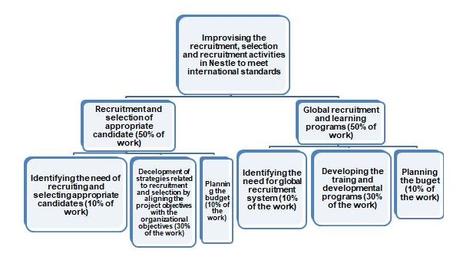
(Source: Created by Author)
(Source: Created by Author)
P4. Carry out small scale research by applying qualitative and quantitative research methods appropriate for meeting project aims and objectives.
Research methodology stands for a systematic plan which is used in order to conduct a research. Basically there are three types of research methodologies namely observational method, survey method and case study method. The project research will effectively utilize a particular research plan that will ensure the execution of the tasks, for the successful completion of the project.
Justification: For this particular research, survey method is utilized wherein the respondents will be administered through survey questionnaires and interviews because this will enable the organization to make the decision effectively in a stipulated time frame. In addition to that this method also ensures the identification of the problem area related to the project.
Data collection method is viewed as a process wherein the data for the project are collected and measured for the purpose of meeting the objectives if the project. The method is segmented into primary data collection method and secondary data collection method.
Justification: In this project, the primary data are collected through survey method. Both quantitative and qualitative data are collected through survey questionnaires and interview. Primary data collection method is embraced in this case because it ensures the accuracy and validity in the research process.
Sampling criteria is considered as an important aspect while conducting the research because it effectively determines the validity of the research. In case of Qualitative research, information was collected by interviewing 2 managers of Nestle regarding the recruitment, selection and training procedures of the company has been incorporated in this project. However, in the case of quantitative data collection, the project incorporated information or data that was collected from an online survey on 25 managers belonging to different multinational organizations depending on different aspects of recruitment, selection and the training procedure of the company in the global market.
Q1. What is your age?
(Source: created by the author)
Q2. What is your gender?
(Source: created by the author)
(Source: created by the author)
Q4. How far do you agree that purpose oriented and global training programmers can improve the skills and competencies of the employees?
(Source: created by the author)
(Source: created by the author)
Q6. What according to you are the biggest criteria to meet the international requirements of human resource management Nestle?
(Source: created by the author)
Q7. What should be the recruitment and selection practices for multinational companies?
(Source: created by the author)
Q8. How far do you agree that incorporating ATS in the recruitment and selection is effective for the multinational organizations in meeting the international requirements?
(Source: created by the author)
Q1. What changes, according to you, have been and should be incorporated in the international human resource policy of Nestle to meet the standards?
Q2. How according to you the performance of the employees can be improved through training and developmental opportunities?
Q3. As per you, how effective are the human resource management Nestle policies
and resources regarding the recruitment and selection within Nestle, for meeting organizational goals and objectives?
P5. Analyze research and data using appropriate tools and techniques.
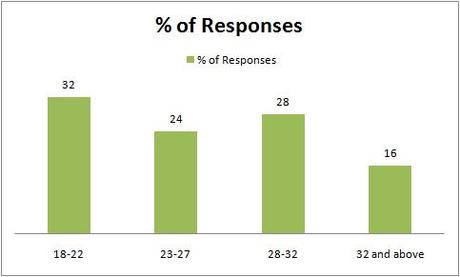
(Source: created by the author)
During the quantitative research, the managers who were surveyed through online platformer were asked about their age group. The survey result revealed that most of the managers belonged to the 18-22 age group. Hence, it can be said that the survey is done involving mostly the young age group of society.
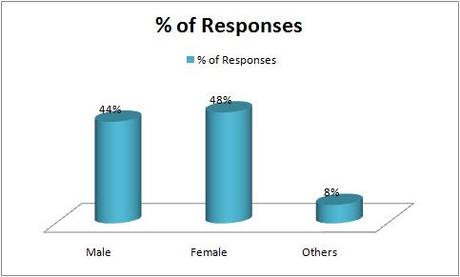
(Source: created by the author)
The second question was asked to have an idea about equality in the managerial positions in companies based on gender. According to the survey, it is evident that most of the respondents were women and the percentage was 48%. On the other hand, the percentage of male respondents was 44%. 8% of the total respondents who were interviewed belonged to other groups. Thus, it could be said that equality is becoming an integral part of the international human resource management Nestle and employees are recruited with the perception of non-discrimination.
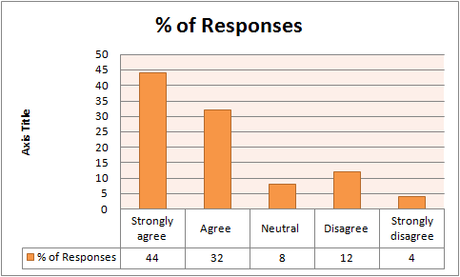
(Source: created by the author)
From the survey result, it can be seen that 44% of the total managers surveyed strongly agree that on-job training is a necessity in order to improve employee performance. 32% of the respondents also agreed with the statement, which implies that most of the managers are supporting the positive impact of on-job training on employee performance. 12% of the respondents have disagreed with the current statement. The median value of the data set is 2 and the mean is 2.12 which lie very close to one another. This indicates that the data set is left skewed and distributed in an almost symmetric way. The SD value of the dataset is 1.24, which is less than the mean and indicates that the data is authentic and unbiased.
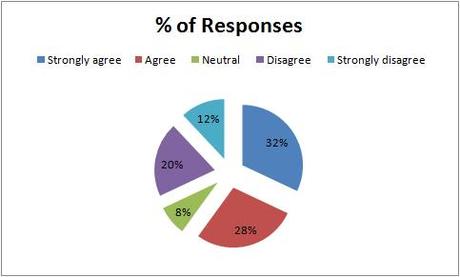
(Source: created by the author)
From the statistics of the survey, it can be said that most of the managers are agreeing that a purpose-oriented approach and global training approach of employee training and development program is capable of improving the professional skills and competencies of the employees. However, 20% of the managers disagreed with the present statement. From the overall result, it can be concluded that the purpose-oriented approach is effective but not crucial in improving employee performance. The mean and median value of the dataset is 2.52 and 2 respectively which are not very close, however, it indicates that the distribution of the data is symmetric and left skewed. The SD value is lower than the mean value implying the authenticity and unbiased nature of the data.
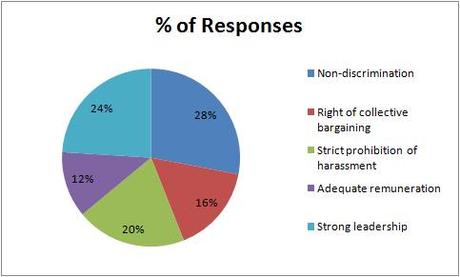
(Source: created by the author)
From the survey result, it is identified that most of the human resource managers support no discrimination while recruiting and selecting candidates as employees in their own organization. It has been also identified that strong leadership is another crucial element as per 24% of the surveyed managers. 20% of the managers supported that the human resource policy must include the principle for the strict prohibition of harassment in the workplace. The data reveals the major principles that are necessary for the formation of human resource policy in the international context.
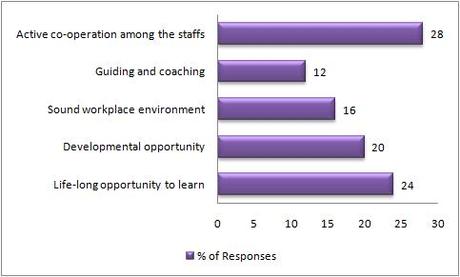
(Source: created by the author)
From the above statistics, it could be seen that according to the opinion of 28% of the managers an active co-operation among the employees is essential which can help in meeting the requirements of the organizations in an international context. However, a large number of managers also support a life-long learning opportunity and developmental opportunity.
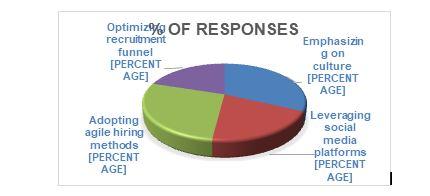
(Source: created by the author)
Based on the criteria of best recruitment and selection procedure in the multinational companies, it is evident that most of the respondents that is 32% considered the option of emphasizing on the culture because of diversity in the workforce. Thereafter, the recommended option is adopting agile hiring methods (28%) through which appropriate candidates for the organization could be hired. 20% of the participants supported the advertisements on social media platforms for recruiting desired candidates and rest 20% opted for recruitment funnel.
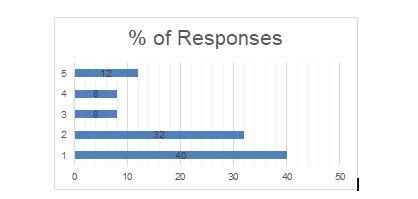
(Source: created by the author)
From the above statistic results, it can be said that most of the respondents that are 40% strongly agree that implementation of ATS would be beneficial to the multinational organizations. However, 12% of the respondents strongly disagreed with the facts and stated some technological issues against the application. The median value of the data set is 2 and the mean is 2.2 which lie very close to one another which indicate that the data set is left skewed and distributed in an almost symmetric way. The SD value of the dataset is 1.38, which is less than the mean and indicates that the data is authentic and unbiased.
Analysis of the qualitative data:
According to the first manager, the employees are the major asset of the company and thus they are more valuable than its factories, physical structures and the brand of the organization. As Nestle is a multinational company, it operates with people from different religious, cultural backgrounds and nationalities (Albrecht et al., 2015). The company has already taken steps to unify the employees in its outlets in different countries and continents.
The second manager has supported the statement of the first manager. He has further stated that the organization supports no discrimination and do not entertain any kind of harassment in the workplace which helps it to build up a healthy working environment. According to him, it is the responsibility of the managers to check that all the employees are being trained in a proper way and to guide them with particular courses that can help them in progressing in their careers. In the new approach of human resources, employees are continuously asked to improve their professional skills.
The first manager stated that Nestle uses to run thousands of training programmers every year as it is the belief of the organization that offering the proper opportunity to the employees for developing helps them to improve their professional skills. Apart from that, it enables the employees to become more confident, autonomous and employable. When employees are provided with proper developmental opportunities they become more open to the new positions where they are employed in the future (Stone et al., 2015).
According to the second manager, Nestle approaches to train its employees with a formal training program. These programs are mainly focused on a purpose-oriented approach that is designed in a manner that can make improvements in the competencies and skills of the employees. Such a program is very effective in improving the performance of the employees as this also motivates the employees and allows them to feel valued.
According to the first manager, the new international human resource policy of the organization regarding recruitment and selection is capable in enhancing the organizational performance because it includes hiring appropriate candidate. The IHRM policy of Nestle ensures that the skillful and knowledgeable employees are hired for the organization who can match the international standards. This has been directly reflected in the employee turnover rate, which has been drastically decreased especially in the developing countries.
The second manager agreed that the employee turnover rate is decreased in most of the countries, however, said that in developed countries the rate unchanged. He has also stated that the improved working environment has helped to decrease the absenteeism of the employees which is a positive implication of the new HR policies of the company.
P6. Communicate appropriate recommendations as a result of research and data analysis:
Recommendation 1: As per the understandings drawn from the research and data analysis of this study, this may be recommended that opting for précised approaches for training and development will be highly accepted by the employee end.
Recommendation 2: Another recommendation that may ne affirmed would the inclusion of international standard of training and work policies will allow an organization to build a positive atmosphere within the workplace.
Recommendation 3: This may further be recommended that developing a sense of co-operation among the workers in a workplace may produce a few positive outcomes. In addition to this, the practices regarding hiring and recruitment needs to aim and focus on cultural diversities and may include the application of tools like ATS.
P7. Reflect on the undertaking the research to meet the stated objectives and own learning and performance
1. What are your positive points or strengths while conducting the research?
The successful research requires effective communication skill and I have excellence in the skill. Effective communication in the entire research process is my strong point with which I overcame the issues. The respondents of the survey were reluctant in filling up the questionnaires because the aim and the objective of the project were not explained to them. In addition to that they were not motivated with such kind of projects. Thereafter I personally interacted with these twenty five individuals who were selected for the survey and hence explained the issue to them and made them realise that improvisation in the HR activities will also enable them to increase their organizational productivity. After a long time conversation I was able to convince them to fill up the questionnaire. The research process also enabled me to learn statistical tools and techniques for interpreting the collected data in a more effective way . While conducting the interviews with the managers of Nestle there was some time related issues because the managers were busy with their work and were unable to manage their time. In this context, my time management skill enabled me to conduct the interview effectively. I conducted the interview in small parts rather than conducting the same as a whole that is whenever the managers were free from their work I use to conduct the interview through phone calls. My analytical skill is also my strong point because I analyzed the data that were collected from the respondents with the help of the statistical tools.
2. What are the major weaknesses in you which had a negative impact on the research?
Apart from my strong points I also have some weaknesses which I have encounter while conducting this project. I do not possess excellent communication tool that is to say I can explain the terms and requirements of the project but is unable to encourage and motivate my people towards the unified aim. In other words I can say that my team members work efficiently but does not have unified aim and as a management consultant I would have engaged them properly in accomplishment of the unified goal and objectives of the project. For improving my leadership quality during the progression of this project, I have experienced that being focused on the goal and objective in the toughest situations is one of the important leadership qualities which must be improved. Confidence is another requirement to lead a project.
(Source: Created by Author)
From the above-conducted research project, a conclusion can be made on the perspective and strategies of multinational organizations like Nestle for improving the procedure of recruitment, selection, and training of the staff in the era of globalization. The company pays greater attention to the training and development of its employees. The organizational culture of the organization based on a single corporate culture that is able to unify the employees who are from different backgrounds and cultures. The study reveals that the approach of the organization is much effective for meeting the standards of international human resources management Nestle.
Albrecht, S.L., Bakker, A.B., Gruman, J.A., Macey, W.H. and Saks, A.M., 2015. Employee engagement, human resource management practices and competitive advantage: An integrated approach. Journal of Organizational Effectiveness: People and Performance, 2(1), pp.7-35.
Beck, U., 2018. What is globalization?. John Wiley & Sons.
Bompa, T.O. and Buzzichelli, C., 2018. Periodization-: theory and methodology of training. Human kinetics.
Bratton, J. and Gold, J., 2017. Human resource management: theory and practice. Palgrave.
Cooke, F.L., 2018. Concepts, contexts, and mindsets: Putting human resource management research in perspectives. Human Resource Management Journal, 28(1), pp.1-13.
Crane, D., Kawashima, N. and Kawasaki, K.I., 2016. Culture and globalization theoretical models and emerging trends. In Global culture (pp. 11-36). Routledge.
Hanapiyah, Z.M., Daud, S., Abdullah, W.M.T.W. and Sanusi, Z.M., 2019. Effect of Training and Development, Recruitment and Selection, and Internal Control Policy on Corruption Risk. The Journal of Social Sciences Research, pp.128-139.
Huo, B., Han, Z., Chen, H. and Zhao, X., 2015. The effect of high-involvement human resource management practices on supply chain integration. International Journal of Physical Distribution & Logistics Management, 45(8), pp.716-746.
Kasemsap, K., 2016. Developing a framework of human resource management, organizational learning, knowledge management capability, and organizational performance. In Project Management: Concepts, Methodologies, Tools, and Applications (pp. 371-402). IGI Global.
Landers, R.N. and Schmidt, G.B., 2016. Social media in employee selection and recruitment: An overview. In Social Media in Employee Selection and Recruitment (pp. 3-11). Springer, Cham.
Navimipour, N.J., Rahmani, A.M., Navin, A.H. and Hosseinzadeh, M., 2015. Expert Cloud: A Cloud-based framework to share the knowledge and skills of human resources. Computers in Human Behavior, 46, pp.57-74.
Sharf, R.S., 2016. Applying career development theory to counseling. Nelson Education.
Sitzmann, T. and Weinhardt, J.M., 2018. Training engagement theory: A multilevel perspective on the effectiveness of work-related training. Journal of Management, 44(2), pp.732-756.
Stone, D.L., Deadrick, D.L., Lukaszewski, K.M. and Johnson, R., 2015. The influence of technology on the future of human resource management. Human Resource Management Review, 25(2), pp.216-231.
Turner, B.S. and Holton, R.J. eds., 2015. The Routledge international handbook of globalization studies. Routledge.
